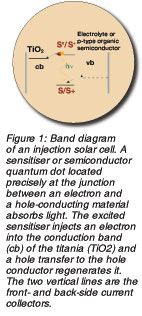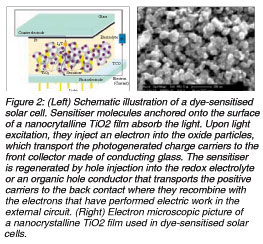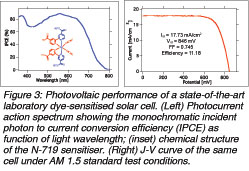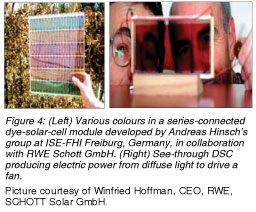|
by Michael GRÄTZEL
 olar cells that copy nature’s very own energy-conversion process could constitute the next generation of green energy-generating sources. Based on photosynthesis, in which plants transform the sun’s rays into stored energy, mesoscopic injection solar cells offer credible and attractive alternatives to solid-state p-n junction devices (explained below). These relatively new nanocrystalline photovoltaic devices, which were invented in the early 1990s, promise viable solutions to future large-scale solar-energy conversion issues on the bases of cost, efficiency, stability, availability, and environmental compatibility. olar cells that copy nature’s very own energy-conversion process could constitute the next generation of green energy-generating sources. Based on photosynthesis, in which plants transform the sun’s rays into stored energy, mesoscopic injection solar cells offer credible and attractive alternatives to solid-state p-n junction devices (explained below). These relatively new nanocrystalline photovoltaic devices, which were invented in the early 1990s, promise viable solutions to future large-scale solar-energy conversion issues on the bases of cost, efficiency, stability, availability, and environmental compatibility.
Operational Principles
 Mesoscopic injection solar cells operate in an entirely different manner from conventional solar p-n junction devices. Mimicking the principles of solar-energy conversion that natural photosynthesis has successfully adopted over the last 3.5 billion years, they separate light harvesting from charge-carrier transport. The semiconductors that conventional cells use assume both functions simultaneously, imposing stringent demands on purity and entailing high material and production costs. Mesoscopic injection solar cells operate in an entirely different manner from conventional solar p-n junction devices. Mimicking the principles of solar-energy conversion that natural photosynthesis has successfully adopted over the last 3.5 billion years, they separate light harvesting from charge-carrier transport. The semiconductors that conventional cells use assume both functions simultaneously, imposing stringent demands on purity and entailing high material and production costs.
In contrast, an injection solar cell has a molecular sensitiser or semiconductor quantum dot located at the junction between an electron (n) and a hole-conducting (p) semiconductor or an electrolyte (Figure 1), which absorbs the solar light. Upon excitation, the absorber injects an electron and a hole into the n- and the p-type materials, respectively, resulting in the photo-generation of charge carriers, collected at the front and back of the device. The photovoltage developed by the cell corresponds to the difference in the electrical potentials of the two materials under illumination.
This cell configuration has the great advantage that the solar-energy-conversion process involves only majority charge carriers. Electrons and holes are generated in different phases, and the presence of the sensitiser significantly blocks their recombination across the interface. A flat junction, however, allows absorption of a few percent at most of incident sunlight, entailing very small conversion efficiencies since the optical cross-section of a dye or quantum dot is much smaller than the area it occupies. The introduction of a nanocrystalline titania (TiO2) film to support the sensitiser has overcome this fundamental problem of harvesting solar light efficiently.
 Mesoscopic morphology produces an interface with a huge area endowing these systems with intriguing optoelectronic properties. The Laboratory for Photonics and Interfaces at the Ecole Polytechnique Fédérale de Lausanne in Switzerland has invented a prototype of this family — the dye-sensitised solar cell (DSC). Figure 2 shows a schematic of the cell along with a scanning electron microscope picture of a typical nanocrystalline TiO2 film. Mesoscopic morphology produces an interface with a huge area endowing these systems with intriguing optoelectronic properties. The Laboratory for Photonics and Interfaces at the Ecole Polytechnique Fédérale de Lausanne in Switzerland has invented a prototype of this family — the dye-sensitised solar cell (DSC). Figure 2 shows a schematic of the cell along with a scanning electron microscope picture of a typical nanocrystalline TiO2 film.
Photovoltaic Performance
The DSC currently reaches 11.2% energy conversion efficiencies under standard reporting conditions in liquid-junction devices. Figure 3 shows typical photovoltaic performance data. Solid-state equivalents using organic hole-conductors have exceeded 5% efficiency whereas nano-composite films comprising only inorganic materials, such as TiO2 and CuInS2, have achieved efficiencies of between 5 and 6%. New dyes showing increased optical cross-section and capable of absorbing longer wavelengths are currently under development. Similarly, scientists expect nanomaterial research to improve cell performance. Other current research focuses on solid-state hole conductors and tandem cell structures as well as quantum dot sensitisers to boost the conversion efficiency further.
 Contrary to amorphous silicon, which suffers from degradation owing to light-induced defect generation (known as Stabler-Wronski effect), extensive accelerated light soaking tests carried out over the last decade have confirmed the intrinsic stability of the DSC. Recent high-temperature stabilisation has allowed the DSC to meet for the first time the specifications laid out for outdoor applications of silicon photovoltaic cells. Researchers have developed new amphiphilic (water-soluble group connected to a non-polar water-insoluble hydrocarbon chain) sensitisers that demonstrate strikingly stable performance under both prolonged thermal stress and light soaking. Contrary to amorphous silicon, which suffers from degradation owing to light-induced defect generation (known as Stabler-Wronski effect), extensive accelerated light soaking tests carried out over the last decade have confirmed the intrinsic stability of the DSC. Recent high-temperature stabilisation has allowed the DSC to meet for the first time the specifications laid out for outdoor applications of silicon photovoltaic cells. Researchers have developed new amphiphilic (water-soluble group connected to a non-polar water-insoluble hydrocarbon chain) sensitisers that demonstrate strikingly stable performance under both prolonged thermal stress and light soaking.
Industrial Application
 The Australian company Dyesol Inc, the first in the world to manufacture DSC modules commercially, organised a conference in February 2006 in Canberra on the Industrialization of Dye-Sensitised Solar Cells, which presented an impressive demonstration of how far this new photovoltaic contender has progressed in less than 16 years after the author’s first scientific publication on this topic. The enthusiastic and upbeat mood of the meeting revealed a consensus among the numerous international participants that the DSC has reached the end of its gestation period and moved forward with its first commercial applications. Building integrated photovoltaic and lightweight flexible applications offers particularly attractive near-term opportunities. Figure 4 exemplifies the possibilities of multicolour modules and see-through power-producing windows using DSC technology. The Australian company Dyesol Inc, the first in the world to manufacture DSC modules commercially, organised a conference in February 2006 in Canberra on the Industrialization of Dye-Sensitised Solar Cells, which presented an impressive demonstration of how far this new photovoltaic contender has progressed in less than 16 years after the author’s first scientific publication on this topic. The enthusiastic and upbeat mood of the meeting revealed a consensus among the numerous international participants that the DSC has reached the end of its gestation period and moved forward with its first commercial applications. Building integrated photovoltaic and lightweight flexible applications offers particularly attractive near-term opportunities. Figure 4 exemplifies the possibilities of multicolour modules and see-through power-producing windows using DSC technology.
 The walls of the Toyota Dream House have installed DSC panels (Figure 5), offering a building-integrated source of solar power to the inhabitants. Dyesol has started pilot production of DSCs in Australia, while British company G24I has built a 20MW plant for flexible DSC fabrication in Cardiff, Wales. The walls of the Toyota Dream House have installed DSC panels (Figure 5), offering a building-integrated source of solar power to the inhabitants. Dyesol has started pilot production of DSCs in Australia, while British company G24I has built a 20MW plant for flexible DSC fabrication in Cardiff, Wales.
Mesoscopic solar cells suit a whole realm of applications ranging from the lightweight low-power market to large-scale applications. Their excellent performance in diffuse light gives them a competitive edge over silicon in providing electric power for both indoor and outdoor standalone electronic equipment. Application of the DSC in building-integrated photovoltaic has already started and will become a rich field for future commercial development.
 Click here to download the full issue for USD 6.50 Click here to download the full issue for USD 6.50
|


 olar cells that copy nature’s very own energy-conversion process could constitute the next generation of green energy-generating sources. Based on photosynthesis, in which plants transform the sun’s rays into stored energy, mesoscopic injection solar cells offer credible and attractive alternatives to solid-state p-n junction devices (explained below). These relatively new nanocrystalline photovoltaic devices, which were invented in the early 1990s, promise viable solutions to future large-scale solar-energy conversion issues on the bases of cost, efficiency, stability, availability, and environmental compatibility.
olar cells that copy nature’s very own energy-conversion process could constitute the next generation of green energy-generating sources. Based on photosynthesis, in which plants transform the sun’s rays into stored energy, mesoscopic injection solar cells offer credible and attractive alternatives to solid-state p-n junction devices (explained below). These relatively new nanocrystalline photovoltaic devices, which were invented in the early 1990s, promise viable solutions to future large-scale solar-energy conversion issues on the bases of cost, efficiency, stability, availability, and environmental compatibility.
 Mesoscopic injection solar cells operate in an entirely different manner from conventional solar p-n junction devices. Mimicking the principles of solar-energy conversion that natural photosynthesis has successfully adopted over the last 3.5 billion years, they separate light harvesting from charge-carrier transport. The semiconductors that conventional cells use assume both functions simultaneously, imposing stringent demands on purity and entailing high material and production costs.
Mesoscopic injection solar cells operate in an entirely different manner from conventional solar p-n junction devices. Mimicking the principles of solar-energy conversion that natural photosynthesis has successfully adopted over the last 3.5 billion years, they separate light harvesting from charge-carrier transport. The semiconductors that conventional cells use assume both functions simultaneously, imposing stringent demands on purity and entailing high material and production costs.
 Mesoscopic morphology produces an interface with a huge area endowing these systems with intriguing optoelectronic properties. The Laboratory for Photonics and Interfaces at the Ecole Polytechnique Fédérale de Lausanne in Switzerland has invented a prototype of this family — the dye-sensitised solar cell (DSC). Figure 2 shows a schematic of the cell along with a scanning electron microscope picture of a typical nanocrystalline TiO2 film.
Mesoscopic morphology produces an interface with a huge area endowing these systems with intriguing optoelectronic properties. The Laboratory for Photonics and Interfaces at the Ecole Polytechnique Fédérale de Lausanne in Switzerland has invented a prototype of this family — the dye-sensitised solar cell (DSC). Figure 2 shows a schematic of the cell along with a scanning electron microscope picture of a typical nanocrystalline TiO2 film.
 Contrary to amorphous silicon, which suffers from degradation owing to light-induced defect generation (known as Stabler-Wronski effect), extensive accelerated light soaking tests carried out over the last decade have confirmed the intrinsic stability of the DSC. Recent high-temperature stabilisation has allowed the DSC to meet for the first time the specifications laid out for outdoor applications of silicon photovoltaic cells. Researchers have developed new amphiphilic (water-soluble group connected to a non-polar water-insoluble hydrocarbon chain) sensitisers that demonstrate strikingly stable performance under both prolonged thermal stress and light soaking.
Contrary to amorphous silicon, which suffers from degradation owing to light-induced defect generation (known as Stabler-Wronski effect), extensive accelerated light soaking tests carried out over the last decade have confirmed the intrinsic stability of the DSC. Recent high-temperature stabilisation has allowed the DSC to meet for the first time the specifications laid out for outdoor applications of silicon photovoltaic cells. Researchers have developed new amphiphilic (water-soluble group connected to a non-polar water-insoluble hydrocarbon chain) sensitisers that demonstrate strikingly stable performance under both prolonged thermal stress and light soaking.
 The Australian company Dyesol Inc, the first in the world to manufacture DSC modules commercially, organised a conference in February 2006 in Canberra on the Industrialization of Dye-Sensitised Solar Cells, which presented an impressive demonstration of how far this new photovoltaic contender has progressed in less than 16 years after the author’s first scientific publication on this topic. The enthusiastic and upbeat mood of the meeting revealed a consensus among the numerous international participants that the DSC has reached the end of its gestation period and moved forward with its first commercial applications. Building integrated photovoltaic and lightweight flexible applications offers particularly attractive near-term opportunities. Figure 4 exemplifies the possibilities of multicolour modules and see-through power-producing windows using DSC technology.
The Australian company Dyesol Inc, the first in the world to manufacture DSC modules commercially, organised a conference in February 2006 in Canberra on the Industrialization of Dye-Sensitised Solar Cells, which presented an impressive demonstration of how far this new photovoltaic contender has progressed in less than 16 years after the author’s first scientific publication on this topic. The enthusiastic and upbeat mood of the meeting revealed a consensus among the numerous international participants that the DSC has reached the end of its gestation period and moved forward with its first commercial applications. Building integrated photovoltaic and lightweight flexible applications offers particularly attractive near-term opportunities. Figure 4 exemplifies the possibilities of multicolour modules and see-through power-producing windows using DSC technology.
 The walls of the Toyota Dream House have installed DSC panels (Figure 5), offering a building-integrated source of solar power to the inhabitants. Dyesol has started pilot production of DSCs in Australia, while British company G24I has built a 20MW plant for flexible DSC fabrication in Cardiff, Wales.
The walls of the Toyota Dream House have installed DSC panels (Figure 5), offering a building-integrated source of solar power to the inhabitants. Dyesol has started pilot production of DSCs in Australia, while British company G24I has built a 20MW plant for flexible DSC fabrication in Cardiff, Wales.
 Click here to download the full issue for USD 6.50
Click here to download the full issue for USD 6.50